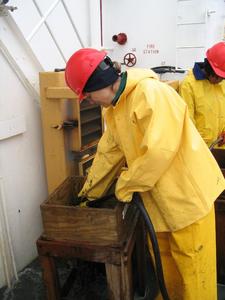
|
|
15 July, 2004
Today has been a really busy day, beginning at 6:30 AM. I knew this would
be my last chance to help out Peter Lee with his underway sampling, so I
took over for him for a few hours while he got some sleep. (See the journal
for the 14th to understand why he gets so little sleep on this cruise.)
Upon waking, we saw a sign on the science white board, "There be killer
whales" signed by the Night Crew. We all missed them but are hoping we'll
see more along the way. Once we were on station at 10:00 we all (our group,
Peter Lee, and Bryan Page) took water samples from the CTD while another
group did bongo nets. We then went on deck to begin sampling mud. For each
station, we take five van Veen grabs and three Haps cores. Unfortunately,
there was no one to take any pictures of the mud sampling today, so I'll
post those later.
The van Veen grabs bring up a scoop full of mud each time. From the first
grab, we take small samples from the top for sediment chlorophyll analysis
and HPLC (see my journal from the 11th). Marinelli beakers measure
Beryllium-7d and Cesium-137 which are used to determine sedimentation rate.
We then dump the mud into a bucket, carry it to sieves, and use hoses to
sieve all the mud from the creatures. Once the mud is removed, the
"critters" are put into containers and preserved to be taken back to the
University of Tennessee for counting and analysis at a later date. Today we
found lots of mollusks (mostly clams and a snail or two), worms, and brittle
stars (a type of pink starfish with long thin arms). While Alicia and I
sieved the samples, Jackie, Ari and Rebecca sent down the Haps core three
times to take core samples of the mud. Jackie takes two of the cores for
her respiration experiments and we take one core from each site to section
the mud. I'll have pictures of all these procedures in future journals.
After completing the sampling work for two stations, Rebecca and I began
sectioning the cores while Ari and Alicia were busy processing the water
samples from the morning. Check my journal from the 13th to see why it
takes time to do these samples. We now have enough samples so Ari and
Rebecca will doing chlorophyll readings every hour for quite a while.
After we finished our on deck sampling, the two scientists involved in
deploying and retrieving moorings came on deck. Their goal was to retrieve
a mooring that had been in place for a year and then to deploy a new
mooring. Unfortunately, when they "pinged" (sent out a signal) for the old
mooring, it didn't "answer" despite the fact that we were right at the
correct latitude and longitude. No answer could mean any of a number of
things. The responder on the mooring may be malfunctioning, the mooring
could have been moved by deep ice or currents, or a fisherman could have
snagged it and moved it. After some searching, they made the decision to
deploy the new mooring and go back to look again for the old one. Not only
does it contain valuable equipment, it also has a year's worth of data
waiting to be downloaded! The only reason I have a break right now is
because they are in the process of dragging for the lost mooring. Our
original plan was to complete three more stations in this area. That would
have put our work well into the early morning hours.

Here I am washing one of our mud samples from the van Veen grab. --

This is what it looks like when a mooring goes in the water. --
Contact the TEA in the field at
.
If you cannot connect through your browser, copy the
TEA's e-mail address in the "To:" line of
your favorite e-mail package.
|
